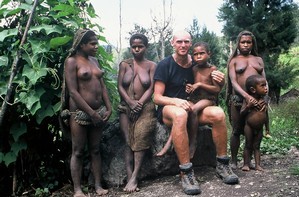BIAK NUMFOR
Traditional and Cultural
The native Biak Numfor whose culture resolves,
arround their ancient animist religion have a fanatical belive in ritual called
Wor, where unless placeted by ceremonies and offering belive they will plagued
by all kinds of bad luck. The Wor is expressed in all aspect of their life.
Like traditional ceremonies ancentral woodcarvings especially in their songs
and dance in lincloths all this which is sacred. Some of traditional
ceremonies, are: The hair cut ceremony (Wor Kapapnik), The growing up ceremony
(Wor Famarmar), The Wedding ceremony (Wor Yakyaker Farbabuk), All of these
ceremonies are compained by singing, dancing and offering to ancentral spirits.
Yosim Pancar Dance
The Biak Numfor friendship dance called Yosim Pancar. It`s to posses and more than one and it`s bases motion that energetic, also dynamic attractive, like the : Pancar Gas dance, Gale gale dance, Seka dance etc.All of the intrumental that used absorption, like : Guitar, Ukelele, and String bas own made it. The accessories producible of local material, such as leaf of sago, root fiber of palm, root of tree, etc. the rhythm and song Yosim Pancar dance are specific there for to put up spirit and breath into dancing; like the symbolized; love song, the beauty nature song and so forth.
The Biak Numfor friendship dance called Yosim Pancar. It`s to posses and more than one and it`s bases motion that energetic, also dynamic attractive, like the : Pancar Gas dance, Gale gale dance, Seka dance etc.All of the intrumental that used absorption, like : Guitar, Ukelele, and String bas own made it. The accessories producible of local material, such as leaf of sago, root fiber of palm, root of tree, etc. the rhythm and song Yosim Pancar dance are specific there for to put up spirit and breath into dancing; like the symbolized; love song, the beauty nature song and so forth.
Barapen Ceremony
Barapen Ceremony is fire-walking tradition perfomed on important events such as celebrating the Independence Day. Another one of them which is quite unique is after a ceremonial procession of initiation. The youth who have just been initiated gather rocks to be burnt. When the rocks are fully burnt, they spread them out, a spiritual leader rubing his feet with a kind of liquid magic formulas, will walk on thr burning rocks
Barapen Ceremony is fire-walking tradition perfomed on important events such as celebrating the Independence Day. Another one of them which is quite unique is after a ceremonial procession of initiation. The youth who have just been initiated gather rocks to be burnt. When the rocks are fully burnt, they spread them out, a spiritual leader rubing his feet with a kind of liquid magic formulas, will walk on thr burning rocks
.





.JPG)

.JPG)





.JPG)

